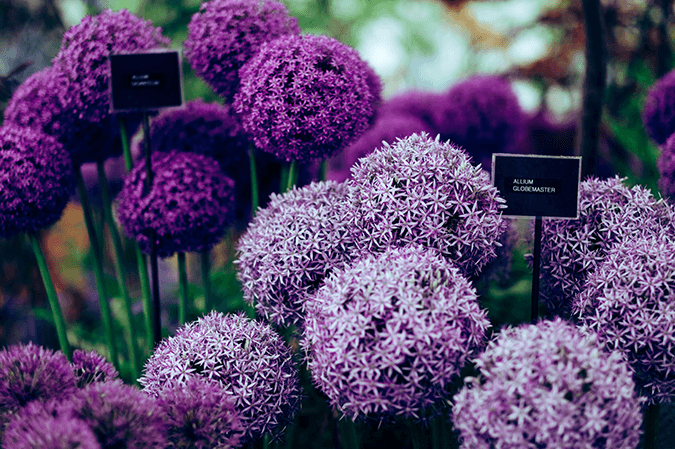Description
Allium is a large genus of flowering plants that includes around 900 species, most notably onions, garlic, leeks, chives, and ornamental varieties. The name “Allium” is derived from the Latin word for garlic. These plants are part of the Amaryllidaceae family and are native to temperate regions of the Northern Hemisphere, particularly in Asia, Europe, and North America. Alliums are known for their distinct, often pungent aroma, which is due to sulfur compounds in the plant. They are popular both as edible plants and as ornamental flowers in gardens.
Common Features
- Leaves: Allium leaves are typically long, narrow, and strap-like, often growing from the base of the plant. The leaves can vary in texture and size depending on the species. In many species, the leaves are semi-cylindrical or flat and tend to die back by the time the plant flowers.
- Flowers: Allium flowers are one of their most distinctive features. They usually form spherical, umbrella-like clusters called umbels, composed of many small, star-shaped florets. The flowers can be found in various colors, including purple, pink, white, yellow, and blue. The flowering stalks, or scapes, are typically leafless and can vary in height from a few inches to several feet tall.
- Bulbs: Most Allium species grow from bulbs, which store nutrients and help the plant survive through winter or drought conditions. The bulbs are typically encased in a papery outer layer and vary in size depending on the species.
- Aroma: Alliums are known for their strong, often pungent aroma, especially when their leaves or bulbs are crushed. This characteristic scent is due to sulfur compounds, which are also responsible for the flavors that make onions, garlic, and other alliums so widely used in cooking.
Role in the Ecosystem
- Pollinator Attraction: Allium flowers are highly attractive to pollinators, including bees, butterflies, and other beneficial insects. The large, conspicuous flower heads provide a rich source of nectar, which helps sustain pollinator populations and supports the overall health of the ecosystem.
- Deterrence of Pests: The strong scent of alliums can act as a natural deterrent to certain pests, such as aphids, and even larger animals like deer and rabbits. This makes them valuable companion plants in gardens, where they can help protect more vulnerable crops from being damaged by pests.
- Soil Health: Alliums can also contribute to soil health by improving its structure and fertility. Their root systems can help aerate the soil, and when their leaves and bulbs decompose, they add organic matter and nutrients back into the soil.
Importance
- Culinary Uses: Allium species such as onions (Allium cepa), garlic (Allium sativum), leeks (Allium ampeloprasum), and chives (Allium schoenoprasum) are essential in cooking around the world. They are used to add flavor to a wide variety of dishes and are a staple in many culinary traditions.
- Medicinal Uses: Many Allium species have been used in traditional medicine for centuries. Garlic, in particular, is known for its antimicrobial, antiviral, and antifungal properties. It has been used to treat infections, lower blood pressure, and improve cardiovascular health. Onions are also believed to have anti-inflammatory and antioxidant properties.
- Ornamental Value: Ornamental alliums, such as Allium giganteum and Allium ‘Globemaster’, are popular in gardens for their striking, architectural flower heads. They add height and visual interest to garden beds and borders, and their long-lasting flowers are often used in floral arrangements.
- Cultural Significance: Alliums have cultural significance in various regions. For example, garlic has been revered in many cultures for its supposed protective properties, while onions have been symbolically associated with layers of meaning and complexity.
Interesting Facts
- Giant Alliums: Some ornamental alliums, like Allium giganteum, can reach heights of up to 5 feet, with flower heads that can be over a foot in diameter.
- Ancient Use: Onions and garlic have been cultivated for thousands of years, with evidence of their use dating back to ancient Egypt, where they were valued for both culinary and medicinal purposes.
- Tear-Inducing Onions: The sulfur compounds in onions are responsible for the eye irritation and tears that occur when cutting them. When an onion is cut, these compounds are released and converted into sulfuric acid, which irritates the eyes.
- Diverse Edibility: Not all alliums are cultivated for food; some are purely ornamental. However, many ornamental varieties are also edible, though they may not be as palatable as their cultivated relatives.
Sources
- Royal Horticultural Society. (n.d.). Allium – Plant Finder. Retrieved from RHS
- Missouri Botanical Garden. (n.d.). Allium – Growing Guide. Retrieved from MBG
- University of Minnesota Extension. (n.d.). Allium – Care and Cultivation. Retrieved from UMN Extension
- National Center for Biotechnology Information. (2020). Garlic (Allium sativum) – Health Benefits and Uses. Retrieved from NCBI



